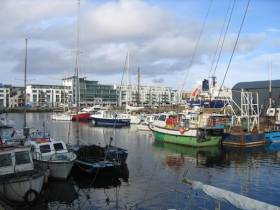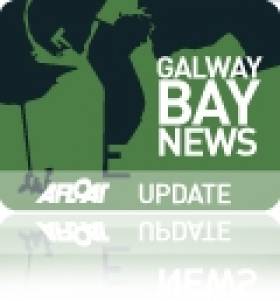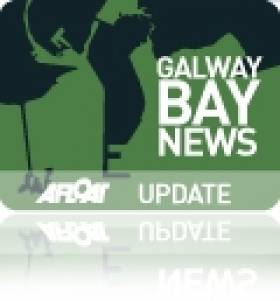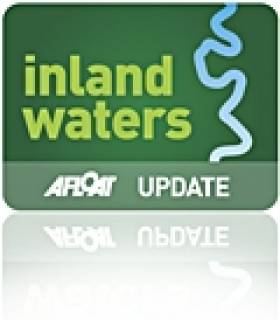Displaying items by tag: River Corrib
Call for Public to Name Galway’s New Salmon Weir Bridge
Members of the public are being invited to suggest names for the new Salmon Weir Bridge in Galway city, as the Connacht Tribune reports.
Built over the course of a year, the cycling and pedestrian bridge across the River Corrib was opened last summer and is the first such span of the waterway in over three decades.
The application form is available from the Galway City Council website and submissions will be open until 6pm on Sunday 11 February.
Transport Minister Eamon Ryan was on hand in Galway on Friday (26 May) to officially open the new span adjacent to the Salmon Weir Bridge over the River Corrib.
As previously reported on Afloat.ie, the first sod was turned on the €3 million active travel project in April 2022.
The cycling and pedestrian bridge is the first new crossing of the Corrib in over 30 years and aims to take pressure off the existing narrow road bridge, which dates from 1818.
Galway Bay FM spoke to some of the first members of the public to use the new bridge and gauged their responses HERE.
The first sod has been turned on constructing a new pedestrian and cycleway across the river Corrib – the first new bridge over the Atlantic coast river in over 30 years.
The new Salmon Weir crossing will “draw pedestrians and cyclists and facilitate a seamless and natural flow from either side of the river, while creating an iconic focal point for locals and tourists alike”, according to Galway City Council.
The project is funded by the European Commission through the European Regional Development Fund, and the National Transport Authority.
“This world-class bridge will remove current conflicts between pedestrians and cyclists, and traffic, and will enhance links between both sides of the river, as well as facilitating the Cross-City Link public transport corridor over the existing 200-year-old bridge,” Galway city council chief executive Brendan McGrath said.
Minister of State for Transport and Galway West TD Hildegarde Naughton also welcomed the construction.
“Anyone who has, like me, walked across the old bridge, will have been conscious that one slip could lead to a collision given how narrow the footpaths are,” she said.
“ This new shared-use pedestrian and cycle bridge at the Salmon Weir Bridge will bring a number of significant benefits to Galway city, including offering a dedicated safe crossing point for pedestrians and cyclists alike,” Ms Naughton said.
“This is one of over 1,200 projects across the length and breadth of the country to receive targeted funding towards making walking and cycling in our villages, towns and cities safer, more sustainable and enjoyable,” she added.
Planning consent for the new bridge was approved by An Bord Pleanála on August 16th last year, and the construction tender was issued in December.
A contractor was appointed in March of this year, and some advance works, including tree felling, took place before the end of February. Galway City Council anticipates the bridge will be “substantially completed by early 2023”.
Galway City Council has welcomed An Bord Pleanála’s approval for a new pedestrian and cycle bridge adjacent to the Salmon Weir Bridge over the River Corrib.
The council’s chief executive said the new bridge is a part of its Galway Transport Strategy, which aims to “enhance sustainable travel within the city centre and reduce dependency on the private motor vehicle, in line with national transport and planning policies”.
Brendan McGrath added: “This decision to approve the project is great news, and now allows us to progress it to the next stage.
“This significant development will tie in closely with other projects such as BusConnects Galway, public realm improvements on Newtownsmith and the creation of a civic plaza at the cathedral/Gaol Road.
“These will all work together to create safer spaces for pedestrians and cyclists as they move through the city, as well as a more enjoyable public realm for all.”
The bridge will be co-funded under the European Regional Development Fund with matched funding from the National Transport Authority.
A public consultation on the bridge plans ran last summer via virtual ‘information rooms’ to compensate for the lack of in-person events due to the pandemic.
Following completion of design documents, the construction contract will be opened to tender early next year, the council says.
Two Drown In Separate Galway Incidents
#Galway - BreakingNews.ie reports that two people are dead after separate drowning incidents in Galway city yesterday afternoon (Saturday 11 June).
North of the city, the body of a 19-year-old man was recovered from the River Corrib near NUI Galway around 2pm.
At the same time, the body of a woman thought to be in her 40s or 50s was discovered in Galway Docks. BreakingNews.ie has more HERE.
Search For Missing Woman In Galway City River
#Missing - Galway Bay FM reports that emergency services are searching for a woman seen entering the River Corrib in the Galway city around 2.30am this morning (Sunday 31 January).
The missing woman was last spotted entering the water from the walkway between O'Brien's Bridge and Newtownsmith, but so far there has been no trace of her whereabouts.
Update: Galway Bay FM now reports that a body as yet unidentified has been recovered from the water in Galway Harbour.
President Opens Refurbished Galway Fishery Watchtower
#GalwayHarbour - President Michael D Higgins performed the official opening of the Fishery Watchtower Museum at Wolfe Tone Bridge in Galway city centre last Friday 24 March.
Inland Fisheries Ireland (IFI) worked in partnership with Duchas na Gaillimhe/Galway Civic Trust in revitalising the Victorian-era structure at the mouth of the River Corrib.
As owner of the tower, IFI said it was acutely aware of its responsibility to preserve the protected landmark and to ensure that safe access was provided.
The Watchtower was acquired when the Galway Fishery, popular for salmon angling, was purchased by the State in 1978.
At that time, the tower had a very practical purpose and in addition to monitoring salmon movements was also used to ensure that no untoward activity (poaching) occurred on the adjacent section of the Corrib, as well as acting as a base for a salmon draft net station. Following the purchase by the State netting of salmon ceased.
From 1997, the tower was operated by the trust as a tourist attraction and fisheries museum under a licence agreement with the WRFB, which was subsequently subsumed into IFI, and proved popular with tourists and locals alike up until the tower became inaccessible in 2007 due to deterioration in the access bridge.
With safe access to the tower no longer available, pressure came on for the bridge to be replaced, and the work of Delo Collier of the trust, in never giving up on the project, was instrumental in bringing about the provision of the new bridge and refurbishment works.
Others key to bringing the tower back to life include IFI fishery manager Seamus Hartigan and Caroline McNeill, involved in the management of the interior refurbishment.
IFI also acknowledged the support of Galway City Council throughout – in particular that provided by Kevin Swift, who worked with IFI and the trust when funding was being sought through Fáilte Ireland over a number of years to replace the bridge.
When Fáilte Ireland eventually advised in early 2012 that it could not support the project, IFI decided to proceed and fund the new bridge with some support from Galway City Council.
The old collapsed bridge, which had stood for 160 years since the tower’s construction in the mid-1800s, was removed by IFI personnel in June 2012 – not an easy undertaking given its location and dangerous condition.
The new replacement bridge was designed by local architects Simon J Kelly & Co and blends in seamlessly with the pedestrian walkway on the upstream side of Wolfe Tone Bridge, which it abuts. The new bridge was installed by Ward & Burke Construction Ltd in March 2013 and engineering and advisory services were provided by ARUP.
Following the installation of the new bridge, the trust and IFI again had easy access to the tower and work began in partnership to refurbish the building which had deteriorated over the previous number of years.
IFI is sure anyone who has the opportunity to visit the tower will be impressed with the work done, the museum exhibits and of course the unobstructed panoramic views of Galway Bay and the lower Corrib.
Since its 'unofficial' opening in late summer 2014, almost 4,000 have visited the tower, and IFI says the comments in the visitors book have been very complimentary.
The fisheries body is also sure that anyone who has the opportunity to visit – whether tourists or local Galwegians – will be impressed with the work done, the museum exhibits and the unobstructed panoramic views it affords of Galway Bay and the lower Corrib.
Probe Into Death Of Galway River Bridge Jumper
#Drowning - BreakingNews.ie reports that the Garda Ombudsman is investigating the death of a man whose body was recovered from the River Corrib in Galway city some time after he was stopped at a Garda traffic checkpoint.
The Irish Coast Guard and Galway RNLI were involved in a major search and rescue operation last night after the man was seen jumping into the river from O’Brien’s Bridge around 6.30pm. His body was found at Lough Atalia an hour later.
'Dangerous' Steel Piles in Corrib as Galway Harbour Reports Losses
#GALWAY BAY NEWS - The Connacht Sentinel reports that a series of steel piles in the River Corrib in Galway city centre are to be removed over concern at the danger posed to canoeists and kayakers.
The eight stanchions, which were installed at the mouth of the Corrib as part of the support structure for the temporary pedestrian bridge across the river during the Volvo Ocean Race finale last month, will be removed "as soon as possible" according to Galway City Council.
A spokesperson for the council said race organisers Let's Do It Global had encountered difficulties removing the steel piles from the stretch of water between the Spanish Arch and Claddagh Quay due to "unfavourable tides and poor weather".
Meanwhile, the Galway Harbour Company has declared that it made more profit from its car parking operation than from harbour activities.
Galway Bay FM reports that the company's accounts for 2011 show that more than 50% of its income is derives from car parking and rent.
Overall the harbour operator saw an 8% fall in revenue on the previous year, with a disappointing 18% drop in throughput. No comment has yet been made on these figures.
Bridge Report Could Herald New Corrib Crossing for Galway
#RIVER CORRIB - A consultant’s report on Wolfe Tone Bridge in Galway could clear the way for a new crossing of the River Corrib, according to The Connacht Sentinel.
Galway City Council has confirmed that the €400,000 report will look at the possibility of a new bridge for vehicular traffic downstream of the existing span.
“Given the age of the current structure, we have to look at plans for the construction of a new bridge and the retention of the existing crossing as part of a walkway over the Corrib," said the council's director of services Ciarán Hayes.
“There is no doubt that such a walkway, as part as an overall regeneration plan for the area, would be a most welcome addition to the amenity infrastructure of this historic part of the city."
The €400,000 allocation for the report commission will comes from the National Roads Authority and Department of the Environment budget for regional and local roads in 2012. The report is expected to be carried out later this year.
































































